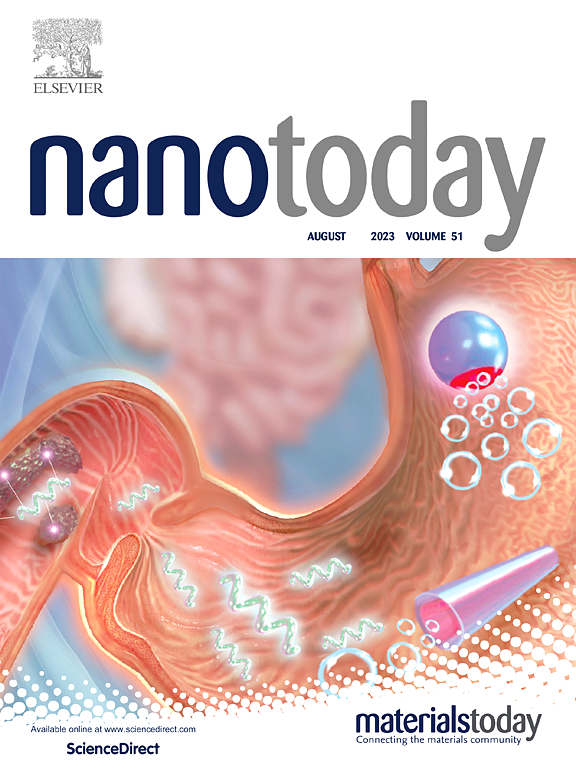Spatially confined multivalent aptamers in the cavity of a DNA nanocage against bacterial superantigens infection
IF 10.9
1区 材料科学
Q1 CHEMISTRY, MULTIDISCIPLINARY
引用次数: 0
Abstract
Aptamers as single-strand oligonucleotides obtained through in vitro screening techniques exhibit significant application potential due to their high target specificity, strong binding affinity, and inherent inhibitory capabilities. However, the easy entanglement among single-strand aptamers and excessive flexibility remains a huge challenge for keep high binding capabilities and dispersed spatial positioning in practical applications. Herein, we rationally designed a DNA nanocage structure loaded with multiple neutralizing aptamers (DNC-Apt). The programmability and the spatial confinement effect of DNC enable multiple single-strand aptamers to be reasonably fixed in the ideal spatial positions and achieve enhanced structural stability. Taking the enterotoxin A and B (SEs) secreted by Staphylococcus aureus as model target, both molecular docking and the ELONA experiment confirmed that the neutralizing aptamers integrated by this strategy achieved binding to different antigenic epitopes on SEs rely on spatially dispersed positioning, and exhibited enhanced binding ability (∼ 6 fold). The PBMC cell proliferation experiment demonstrated that this strategy could mediate the binding of SEs to receptors, thereby reducing the proliferation of T cells and the release of pro-inflammatory factors. Furthermore, the application of DNC-Apt in mice significantly reduced the inflammatory response and tissue damage caused by SEs. In conclusion, our research provided a reference for enhancing the application ability of aptamers and offered new strategies for alleviating the toxicity of bacterial toxins.
DNA纳米笼腔中空间限制的多价适体对抗细菌超级抗原感染
通过体外筛选技术获得的核酸适体作为单链寡核苷酸,具有较高的靶向特异性、较强的结合亲和力和内在的抑制能力,具有重要的应用潜力。然而,在实际应用中,单链适体之间容易缠结,灵活性过大,对保持高结合能力和分散的空间定位仍然是一个巨大的挑战。为此,我们合理设计了装载多个中和适体(DNC-Apt)的DNA纳米笼结构。DNC的可编程性和空间约束效应使多个单链适配体能够合理地固定在理想的空间位置,增强结构稳定性。以金黄色葡萄球菌分泌的肠毒素A和B (SEs)为模型靶点,通过分子对接和ELONA实验证实,通过该策略整合的中和适体依靠空间分散定位实现了与se上不同抗原表位的结合,并表现出增强的结合能力(约6倍)。PBMC细胞增殖实验表明,该策略可以介导SEs与受体的结合,从而减少T细胞的增殖和促炎因子的释放。此外,DNC-Apt在小鼠中的应用显著降低了SEs引起的炎症反应和组织损伤。总之,我们的研究为提高适体的应用能力提供了参考,并为减轻细菌毒素的毒性提供了新的策略。
本文章由计算机程序翻译,如有差异,请以英文原文为准。
求助全文
约1分钟内获得全文
求助全文
来源期刊

Nano Today
工程技术-材料科学:综合
CiteScore
21.50
自引率
3.40%
发文量
305
审稿时长
40 days
期刊介绍:
Nano Today is a journal dedicated to publishing influential and innovative work in the field of nanoscience and technology. It covers a wide range of subject areas including biomaterials, materials chemistry, materials science, chemistry, bioengineering, biochemistry, genetics and molecular biology, engineering, and nanotechnology. The journal considers articles that inform readers about the latest research, breakthroughs, and topical issues in these fields. It provides comprehensive coverage through a mixture of peer-reviewed articles, research news, and information on key developments. Nano Today is abstracted and indexed in Science Citation Index, Ei Compendex, Embase, Scopus, and INSPEC.
 求助内容:
求助内容: 应助结果提醒方式:
应助结果提醒方式:


